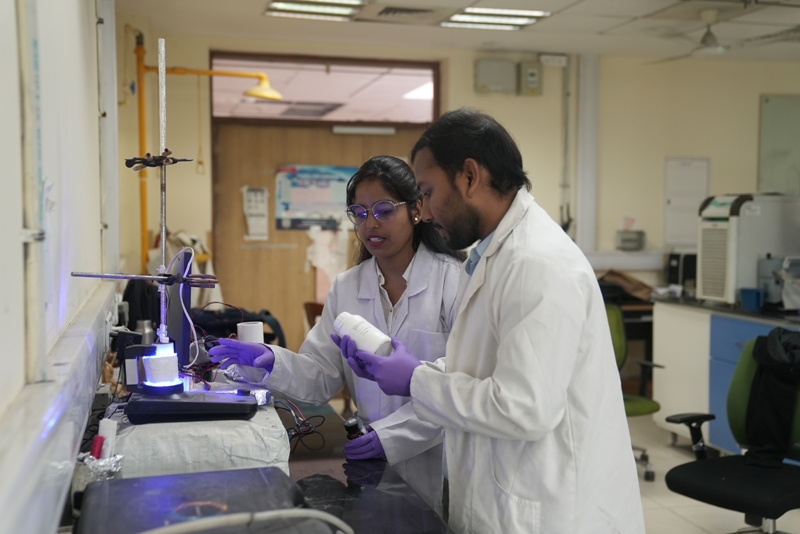By Subhabrata Sen
The 2025 Organic Chemistry Horizon Prize, also known as the Perkin Prize, was awarded to a research group from Shiv Nadar University and the Indian Institute of Technology, Mumbai. They are the first Indian team to receive this prestigious award from the Royal Society of Chemistry, UK, for their work on the development of alternate electrode electrolysis (AEE), which has applications in organic synthesis.
In its award announcement, the Royal Society noted that “This method not only improves the way chemists make molecules but also reduces energy waste, avoids the need for heavy metals or harsh chemicals, and opens the door to greener and more sustainable manufacturing processes”. It has potential to change the way products are made in the pharmaceutical, chemical and agrochemical industries around the world. Professor Subhabrata Sen, who leads the team, explained aspects of the research and its applications in an interview with 360info Commissioning Editor Samrat Choudhury.
How would you explain the key difference between conventional electrolysis and your method, alternate electrode electrolysis?
The basic premise of electrolysis is that you have an electrolyte in which a cathode and anode are introduced. If you have a molecule which you want to react with another molecule, you reduce it at the cathode or oxidize it at the anode, and they give you a new molecule. A fundamental problem which occurs is that as the reaction goes on, over time you get a layer of ions in front of the cathode and another layer in front of the anode. We call this ‘electric double layer’. Whatever molecules are there in your system are unable to reach the individual electrodes because of the electric double layer. It takes a while to form but once it forms, the efficiency of the whole system reduces.
To circumvent this problem, there is a famous person in our field, Phil S. Baran from Scripps Research in southern California, who came up with the concept of rapid alternating polarity. In rapid alternating polarity you are exchanging the cathode and anode at periodic intervals. As a result of this the electric double layer reduces and the system is rejuvenated.
While these strategies are good, there was still room for improvement. So, what we did was, we used two pairs of electrodes instead of a single pair, and through a microcontroller started switching between these pairs. Say we start with Pair 1. After 50 milliseconds we switch to Pair 2. Now Pair 1 is in the resting phase, but the reaction is not. The job is being done by Pair 2. Then we switch back again. What happens is that the electric double layer is able to form to a lesser extent.
Does that imply that if you put in another pair of electrodes that would improve it even further?
One of the reviewers at the journal of the American Chemical Society where this work was first published asked us the same question. The answer essentially is, the job is being done by two sets, and at any point of time when one is working the other is at rest. So even if you introduce a third set, it will be redundant. At present, the electrical set-up is very compact, so primarily a third or fourth set is not required.
In your interview to the Royal Society of Chemistry you described AEE as more energy-efficient and scalable. Could you give examples of where it is likely to outperform traditional methods?
What we have tried to do is we have made the electricity-induced organic synthesis much more efficient, as a result of which all those reactions which could happen under thermal conditions in the pharmaceutical industry, agricultural industry, chemical industry, paint industry…wherever they are performing organic reactions to make molecules in the thermal mode, if we switch it to electric current, eventually it will be alternate electrode electrolysis.
How did the idea come to you?
For the last 5-6 years, we have been working a lot on sustainable organic synthesis. I am extremely lucky to have several brilliant Ph.D students. One of them is Debajit Maiti who has a Masters in Pharmaceuticals.He joined my lab. My lab was driving towards sustainable synthesis. He said he was interested in electrochemical organic synthesis and started to work on this and one thing led to the other. He was one of the pioneers in driving this. In a successful research lab, it is the students who drive the research.
Your work strikes me as interdisciplinary. There’s electrical and electronic engineering involved, I think?
Absolutely. We are developing a few prototypes based on our research and we are actively working with an electrical engineer, who is helping us in developing the prototypes.
You’ve mentioned this method in the context of sustainability. How is this going to reduce waste or carbon footprints?
We are trying to eliminate thermal reactions, substituting them with electricity and light which can be renewable sources. Secondly, we are trying to make our reactions catalyst-free, removing not only the reagents but also the metal catalysts. This will become industry-friendly, environment-friendly. We are also trying to use a lot of green solvents in our reactions.
Are there any industries that are more likely to benefit from this method?
The pharmaceutical, chemical and agrochemical industries are the three. I am getting a lot of queries from industries that are getting interested.
What are the challenges you face now for scaling up?
In scaling up, not only the reaction’s kinetics changes, but also the thermodynamics. What we are trying to do is go for a very gradual increase in scale and that is exactly where we are facing the challenge. The efficiency of any electro-organic synthesis depends on the distance between the electrodes. If we have to scale this up, we definitely cannot do it in a batch synthesis setup with several hundred litres of electrolyte in a chamber and huge anodes and cathodes. That is not feasible. What is feasible is flow. The reaction chamber could be small but unlike synthesis in large vats you continue to push in your reaction material continuously to get a product continuously.
And you can put many of them in parallel?
Absolutely. We have to change our mindset from batch reaction to flow reaction.
Do you notice any changes or trends in the field of chemistry?
Integration of automation, flow reactions, these have been in the field for decades. There are big companies in the West that have developed multi-channel reactors that incorporate machine learning. In India, it is getting evolved.
Dr. Subhabrata Sen is a Professor in the Department of Chemistry, Shiv Nadar University. His research group focuses on fundamental and applied research in synthetic organic chemistry.
This interview has been condensed and edited for clarity.
Originally published under Creative Commons by 360info™.















